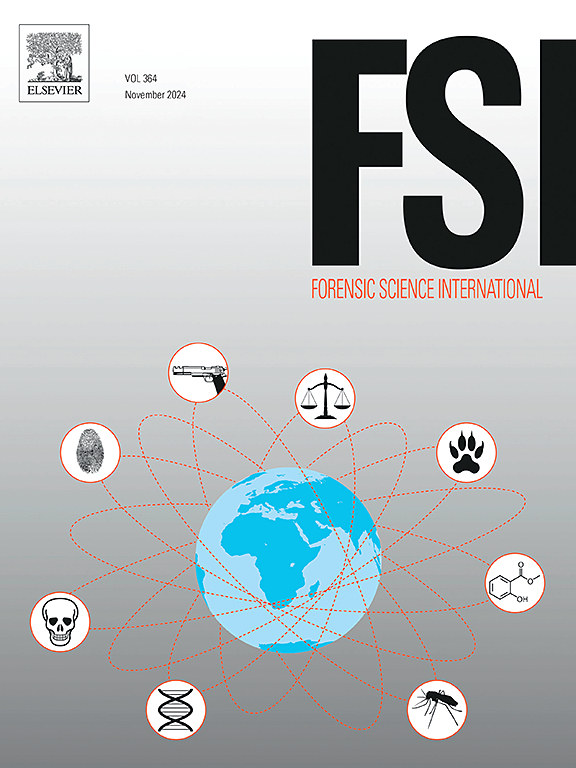The impact of environmental variability and clothing type on the transfer of marine diatoms as trace evidence indicators in coastal locations
IF 2.2
3区 医学
Q1 MEDICINE, LEGAL
引用次数: 0
Abstract
Diatoms are a species-rich group of microalgae, abundant in freshwater, marine, and soil environments. Subsequently, they may be used as a form of trace evidence, reconstructing links between persons and places involved in crime. Despite previous studies demonstrating the forensic value of diatoms in freshwater and soil habitats, no previous research has explored their transfer and persistence dynamics in marine environments. This study therefore aimed to assess diatom transfer to clothing following immersion in five coastal and one freshwater location, offering a novel contribution to the rapidly expanding empirical research base within forensic ecology. Experiments were designed to consider the impact of recipient surface characteristics, environmental variability, and diatom valve characteristics (morphology and species-specific features) on the abundance, species richness, and whole assemblage composition of marine diatoms recovered from clothing. Three common materials – cotton, polyester, and acrylic – were submerged in two marine lakes, two tidal beaches, and one estuary along the Merseyside coast (NW England), and one inland pond to provide a freshwater comparison. Diatoms were recovered from all environmental and clothing transfer samples using a H2O2 extraction protocol before microscopic analysis including species identification. The results demonstrate significant differences in the diatom communities present within the six environmental samples, with multiple site-specific marker taxa and a variable species assemblage between coastal sites. Clothing type and environmental variability significantly influenced the abundance, species richness, morphology, and species composition of marine diatoms transferred to clothing. Notably, the whole species assemblage retrieved from each subset of transfer samples demonstrated relative similarity to the corresponding environmental control sample, supporting forensic comparisons and exclusions with questioned sites. These findings highlight that marine diatoms offer useful circumstantial trace evidence indicators during crime reconstructions involving coastal environments. Furthermore, and similarly to the findings of freshwater research, care must be taken when interpreting marine diatoms as trace evidence indicators in forensic investigations. The complexity of variables influencing the abundance and representativeness of a diatom sample transferred to clothing necessitates exclusionary interpretations to ensure robust and reliable conclusions of evidential significance.
环境变化和服装类型对海洋硅藻迁移的影响,作为沿海地区的痕量证据指标
硅藻是一种种类丰富的微藻,大量存在于淡水、海洋和土壤环境中。随后,它们可能被用作一种痕迹证据,重建涉及犯罪的人和地点之间的联系。尽管以前的研究证明了硅藻在淡水和土壤生境中的法医价值,但以前没有研究探索它们在海洋环境中的转移和持久性动态。因此,本研究旨在评估在五个沿海和一个淡水地点浸泡后硅藻转移到衣服上的情况,为法医生态学中迅速扩大的实证研究基础提供了新的贡献。实验旨在考虑受体表面特征、环境变异性和硅藻阀特征(形态和物种特异性特征)对从衣物中回收的海洋硅藻的丰度、物种丰富度和整体组合组成的影响。三种常见的材料——棉花、聚酯和丙烯酸——被淹没在默西塞德海岸(英格兰西北部)的两个海洋湖泊、两个潮汐海滩和一个河口,以及一个内陆池塘中,以提供淡水对比。在显微镜分析包括物种鉴定之前,使用H2O2提取方案从所有环境和衣物转移样品中回收硅藻。结果表明,6个环境样本中的硅藻群落存在显著差异,存在多个特定地点的标记分类群和不同海岸站点之间的物种组合。服装类型和环境变异对服装转移硅藻的丰度、种类丰富度、形态和种类组成有显著影响。值得注意的是,从每个转移样本子集中检索到的整个物种组合与相应的环境控制样本显示出相对相似性,支持法医比较和排除可疑地点。这些发现强调,海洋硅藻在涉及沿海环境的犯罪重建中提供了有用的间接痕量证据指标。此外,与淡水研究的结果类似,在法医调查中将海洋硅藻解释为微量证据指标时必须小心。影响转移到服装上的硅藻样品丰度和代表性的变量的复杂性需要进行排他性解释,以确保具有证据意义的可靠结论。
本文章由计算机程序翻译,如有差异,请以英文原文为准。
求助全文
约1分钟内获得全文
求助全文
来源期刊

Forensic science international
医学-医学:法
CiteScore
5.00
自引率
9.10%
发文量
285
审稿时长
49 days
期刊介绍:
Forensic Science International is the flagship journal in the prestigious Forensic Science International family, publishing the most innovative, cutting-edge, and influential contributions across the forensic sciences. Fields include: forensic pathology and histochemistry, chemistry, biochemistry and toxicology, biology, serology, odontology, psychiatry, anthropology, digital forensics, the physical sciences, firearms, and document examination, as well as investigations of value to public health in its broadest sense, and the important marginal area where science and medicine interact with the law.
The journal publishes:
Case Reports
Commentaries
Letters to the Editor
Original Research Papers (Regular Papers)
Rapid Communications
Review Articles
Technical Notes.
 求助内容:
求助内容: 应助结果提醒方式:
应助结果提醒方式:


